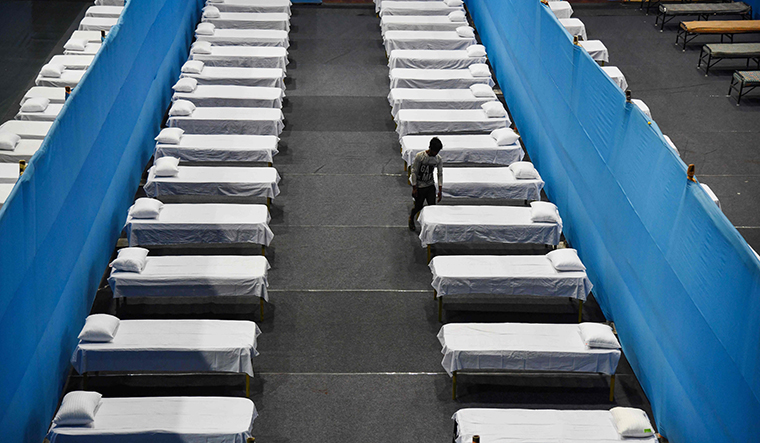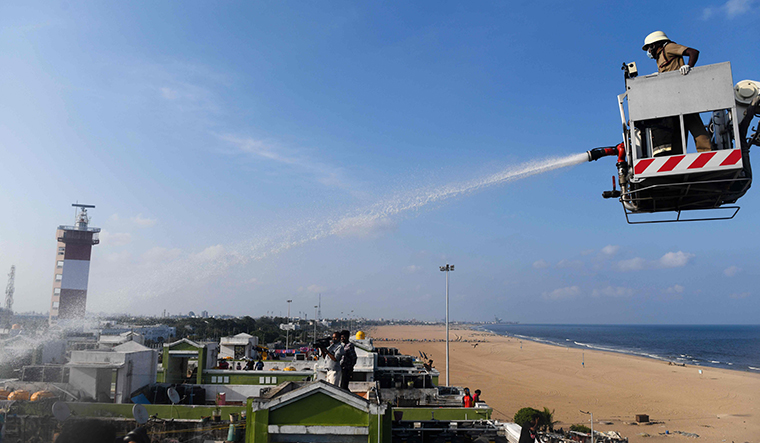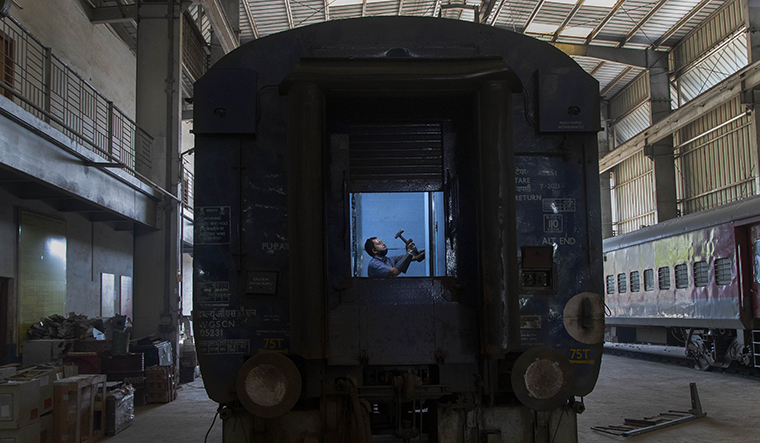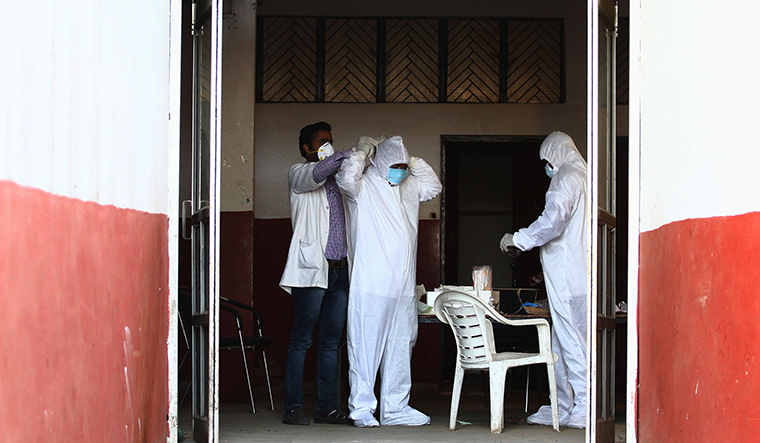Dr Tushar Waykhinde has been living on the G.T. Hospital campus in Mumbai ever since the housing colony in Bhayandar, where he has a flat, asked him to stay out. “They have banned me from my home,” said Waykhinde. His relatives back home are urging him to quit his job and come home; they fear for his safety, as there are not enough gloves, masks and coveralls in the hospital.
Waykhinde is not listening, though. If he does, India will have one trooper less in its thin force of warriors combating a virus that has already killed more than 40,000 people worldwide. The virus is yet to crush India, which has put up its defences with a three-week lockdown to break the transmission chain. Yet, as Dr Tarun Bhatnagar, epidemiologist at the ICMR-National Institute of Epidemiology, Chennai, and member of the national task force against Covid-19, warns, “an epidemic is inevitable. By itself, the lockdown will not help. We are only buying time to prepare the health infrastructure.”
— finalblur (@finalblur) April 13, 2020
As the infrastructure is being fortified, India’s health managers under Union Health Minister Dr Harsh Vardhan are also discovering chinks in their armour. The most glaring is the shortage of doctors and nurses. The World Health Organization prescribes one doctor and three nurses for every 1,000 citizens, but with just 1.16 million allopaths and 3.07 million nurses, India has only one doctor for every 1,445 citizens, and less than two nurses for every thousand.
The shortage may not be crippling in normal times. But, faced with a pandemic that has clobbered western Europe and America, India’s health managers are looking at a nightmarish prospect. With no evidence of community outbreak yet, “we are seeing five times more patients than in normal times”, said Dr Amol Annadate, paediatrician and public health expert in Maharashtra.
The shortage of doctors and nurses, glaring as it is, is the least of the real concerns. A bigger worry is the shortage of hospital beds, ventilators, coveralls, masks, gloves, drugs and other equipment. Maharashtra has just 6,500 isolation beds and 26,000 regular hospital beds (in addition to 13,000 beds in primary health centres). Till the end of March, around 2.7 lakh people had been screened in the state, but alarm bells rang after 25 members of one family in Sangli district were detected with Covid-19. “We are trying to make sure that there is no further transmission,” said Pallavi Saple, dean of Sir J.J. Group of Hospitals, who is leading the firefight in Sangli. “We need people for cleaning the wards, door handles and surface areas. We are introducing automated cleaning services and steam sterilisers.” Saple’s hospital has introduced four-hour shifts for staff in high-risk wards.
Down south, in Tamil Nadu, postgraduate medical students have been working for one week at a stretch, resting for just 14 hours. “Leave alone the hazmat suits, we did not even get enough number of N95 masks and gloves,” said a student.
Many are buying coveralls with their own money, and some have not received their stipend for three months. “You should take care of yourself and others,” said a note sent out on March 24 by the director of Institute of Obstetrics and Gynaecology in the Government Hospital, Egmore, Chennai.
Alarm bells rang in the state after a doctor in Erode and her family were found to have contracted Covid-19. Said Dr K.P. Gujanatham, former city health officer: “Doctors should be given all protection as they are the frontline warriors in the battle.”
Up north, Punjab has been worried ever since a 70-year-old NRI, who later died, reportedly spread the virus to more than two dozen persons in a congregation, including his own kin. About 9,700 people have been in home quarantine in the state; of the 170 who are in hospital, 41 people have tested positive. Four have died.
Punjab’s biggest worry are the thousands who have come from abroad. “The initial figure was 90,000; after checking, the figure is 66,000,” said additional chief secretary K.B.S. Sidhu. “We are asked why did we not go for massive testing, as the WHO had recommended. There is shortage of testing kits. ICMR (Indian Council of Medical Research) has notified a testing protocol, which we are following.”
Jammu and Kashmir, where lockdowns are a way of life even without a pandemic, is facing a peculiar problem. The state has 1.2 lakh policemen for a population of 1.2 crore, but only 2,000 doctors, including temporary hands, and 800 ventilators. In Srinagar, where most Covid-19 patients are being treated, only 3,361 beds are available. “Aiming at 25 beds per 10,000 population, the government will have a total requirement of 7,500 beds, which implies an additional requirement of 4,139 beds,” said a report prepared by the health department.
Even otherwise, medical facilities in the state are dismal. “There are only two washrooms for all patients, including those in quarantine,” said Arif Ahmed, a Srinagar resident whose two daughters, aged seven and four, are the state’s youngest Covid-19 patients. They contracted the disease from their grandfather, who had returned from a pilgrimage to Saudi Arabia.
West Bengal, which boasts 4,000 hospitals and health centres that together have 84,000 beds, is worried on another count. The state’s 62,000 doctors have been combating high death rates because of pneumonia (24 per cent), respiratory illnesses (34 per cent) and diarrhoea (13 per cent)—all of which are symptoms associated with Covid-19 as well. The state is clearing all guest houses, marriage and community halls and other such spaces to set up makeshift hospital wards.
Health care professionals across India admit that there is a severe shortage of hospital beds. A Brookings India report by a team led by Dr Shamika Ravi, and based on data from the Union government’s National Health Profile–2019, says India has just one bed for about 1,000 citizens. The elderly are particularly vulnerable, not only because they are more likely to get sick, but also because “the availability of beds for elderly population in India is 5.18 beds per 1,000 people”, says the report.
Not all states are alike. At one level are states like West Bengal (2.25 government beds per 1,000 people), Tamil Nadu (1.1) and Kerala and Delhi (1.05 beds). Then there are those states that figure below the all-India average of 0.55 beds—Bihar, Jharkhand, Gujarat, Uttar Pradesh, Andhra Pradesh, Chhattisgarh, Madhya Pradesh, Haryana, Maharashtra, Odisha, Assam and Manipur. The big worry—close to a third of India’s population live in these states.
The immediate focus, however, is more on Kerala, Punjab and Telangana, which have a high number of overseas returnees. Among them, Kerala is managing exceptionally well (see story on page 42). Punjab has 889 ICU beds and 387 ventilators in state-run and private hospitals. It has 20 isolation facilities with 2,708 beds earmarked for Covid-19 patients.
Telangana has created more than 12,000 isolation wards with 1,500 ICU beds. With a Covid-19 budget of Rs 500 crore, the state is equipping itself to treat 60,000 patients at a time. Currently, the state has six testing centres and three quarantine centres to accommodate returnees from abroad. The prestigious Centre for Cellular and Molecular Biology in Hyderabad is gearing up to test 1,000 samples a day, while the state government is flying drones to disinfect crowded residential areas.
While states are finding their own ways to get more doctors, nurses, paramedics, beds and volunteers, Union Health Minister Harsh Vardhan’s managers at the federal level are burning midnight oil to combat the shortage of equipment. They currently have a stock of 3.34 lakh personal protective equipment (PPE) spread across India. Another 60,000 PPE kits are being distributed. The Indian Red Cross Society has sourced 10,000 more kits from China, and is counting on getting three lakh coveralls by early April.
The defence ministry’s ordnance factories are churning out another three lakh PPEs. A Singapore-based online platform has been asked to send more, and a Korean supplier has been requested for 20 lakh kits. “The big challenge now is to procure the reagents [for reverse transcription-polymerase chain reaction tests to detect Covid-19], for which there is a shortage everywhere,” said Dr V. Ravi, senior professor of neurovirology, National Institute of Mental Health and Neurosciences, Bengaluru. Ravi’s lab received approval for Covid-19 testing on March 30.
“Only three indigenous kits have been approved by ICMR until now,” he said. “The government should consider expanding the testing criteria, and evolve a stronger case definition for surveillance.” A surveillance case definition, according to the US Centers for Disease Control, is a set of uniform criteria that enables health officials to classify and count cases consistently across reporting jurisdictions.
Union health ministry officials say the shortage of test kits, coveralls, masks and gloves is manifested in the early stages of an outbreak. “These can easily be overcome,” said an official. “Small industries—in India or abroad—can churn out most of these overnight. But if, God forbid, a community outbreak happens, we would have to worry about ventilators, isolation rooms, ICU beds, and so on. These are not easy to make, procure or install.”
That the government was bracing for a crisis became evident when Lav Agarwal, joint secretary in the health ministry, who had been estimating a requirement of 1,200 more ventilators, suddenly declared that India was ordering 40,000 more from the public-sector HLL Lifecare Ltd and Bharat Electronics Ltd. The move signalled that, unlike most of Europe or America, India was readying itself for the breakout battle even before the enemy had unleashed all its fury. On March 30, an empowered group of officers asked the Defence Research and Development Organisation to work out the specifics regarding production of ventilators. DRDO engineers burnt midnight oil and came out with the qualitative requirements in 24 hours. A plant in Mysuru has been given the technology for making special ventilators that the DRDO had developed with the Bengaluru-based Society for Biomedical Technology.
“The industry currently has a capacity to manufacture 5,000 ventilators per month,” DRDO chief G. Satheesh Reddy told THE WEEK. “This could be scaled up to 10,000 per month.” The DRDO’s Defence Bioengineering and Electromedical Laboratory, Bengaluru, is working on a ventilator that can help eight patients at a time.
Military scientists are also developing five-layer masks with two layers of nanomesh. The body suits deployed during biochemical attacks will be made by two private firms that can produce 10,000 suits a day. The sanitiser developed by the DRDO’s Gwalior lab is already in production. About 4,000 litres of it has been given to the armed forces, about 1,500 litres to the defence ministry, 300 litres to Parliament and 500 litres to other high-security setups.
Private industries are also being co-opted into the war effort. “The domestic industry was producing 5,600 ventilators per month,” said Rajiv Nath, coordinator of the Association of Indian Medical Device Industry. “We have been asked to ramp up production ten-fold.”
By the third week of March, the Centre had asked the states to set up exclusive Covid-19 hospitals. The genius of the administration and the Indian talent for jugaad again came in handy. The Indian Railways, which had stopped running trains, offered to convert 20,000 coaches into isolation centres to accommodate 3.2 lakh patients. About 5,000 coaches are already getting ready, which means that there would be 80,000 such beds initially in case of a mass outbreak. The railways are also offering 6,500 beds in its own hospitals, and 2,000 of its ventilators.
As reports of ill-guarded doctors and nurses getting sick trickled in from Erode, Mumbai, Chennai and elsewhere, the rush for masks, gloves and gowns turned into a scramble. Four days into the lockdown, the health ministry ordered 21 lakh coveralls in addition to the 7,000 being churned out from big and small plants across India. “In the next one week, this is expected to go up
to 15,000 per day,” said an official. “An order for five lakh coveralls has been placed with a domestic manufacturer.”
Meanwhile, the states are setting up designated Covid-19 hospitals. In Delhi, the All India Institute of Medical Sciences, India’s Mecca of medical science, shut its doors to the 12,000 outpatients who had been thronging its premises every day. Overnight, the wards were swept clean, scrubbed, fumigated and sanitised.
“We are preparing two facilities,” Dr Randeep Guleria of AIIMS told THE WEEK. “One is at the AIIMS hospital, because many Covid-19 patients may need additional care such as cardiac care or dialysis. Then there is the JPNA Trauma Centre, and the new building behind it. That was meant for a burns and plastic surgery centre, but we are making it the triage area, using their ICUs and special wards. Gradually, we will convert the entire trauma centre for Covid-19 care, and shift the trauma patients to the main hospital. If that is not enough, we would have the National Cancer Institute at Jhajjar, too, where we have more than 500 beds.”
The states, too, are scrambling to bridge the equipment shortage. Punjab is ordering 65 more ventilators, 1.5 lakh PPE kits, more than 47,000 N95 masks, and 13 lakh more triple-layer masks. Karnataka is adding around 4,000 more beds. “We have designated Covid-19 hospitals, like Victoria and Bowring and Lady Curzon hospitals,” said state health commissioner Pankaj Kumar Pandey. “The 250-bed district hospital in Mysuru is being converted into an exclusive Covid-19 hospital. In Yadgir district, we have already [finished] converting one. The 200-bed Broadway Hospital, supported by Infosys Foundation, will be ready soon.”
The situation in Bengaluru, where the population is highly cosmopolitan, is being closely monitored. About 1,000 city squads have been formed to trace and quarantine the primary contacts of all Covid-19 patients. About 150 quarantine violators have been caught. About 1,300 rooms across 17 city hospitals are being readied for quarantine; 10 lakh N95 masks, 15 lakh triple-layer masks and 1,000 ventilators are being procured.
The private sector is also being co-opted. Apollo Hospitals has launched an initiative, Project Stay I, to create 500 isolation rooms in hotels in six cities, including Bengaluru, Mumbai, Kolkata, Chennai, Delhi and Hyderabad. It will benefit 10,000 patients a month and prevent more than 50 lakh infections. “They will be under light medical supervision, leveraging technology at least once a day,” Dr Sangita Reddy, joint managing director, Apollo Hospitals, told THE WEEK. “They will have access to doctors 24/7 through the Ask Apollo App at no charge.”
In neighbouring Andhra Pradesh, Chief Minister Jaganmohan Reddy did some quick thinking. The state has hired 2.5 lakh village volunteers (one volunteer for 50 homes) to check whether welfare benefits are reaching the people and to look for overseas returnees in more than one crore homes twice a month. The state has also earmarked one 100-bed isolation facility in every assembly constituency, and a 200-bed facility in one town in each district. Two ambulances are on standby in every district, and the authorities are tracking the movements of 25,000 quarantined people through a mobile app.
“Right now, we are focusing on community surveillance,” said K.S. Jawahar Reddy, principal secretary (health and family welfare), Andhra Pradesh. “By the time the lockdown is lifted, we will impose restrictions on these clusters to ensure that the contagion does not spread.” Reddy has ordered 60,000 rapid test kits, and is creating quarantine space for 70,000 Covid-19 patients.
Neighbouring Tamil Nadu has earmarked 17,000 beds across the state for Covid-19 patients. “The chief minister recently inaugurated a 500-bed Covid-19 hospital in Chennai,” health secretary Dr Beela Rajesh told THE WEEK. “The state has also appointed 1,508 more lab technicians, 500 doctors and 1,000 nurses, and is augmenting the ambulance fleet with 200 new vehicles.”
Meanwhile, the armed forces are getting into battle gear under Operation Namaste. Quarantine facilities have been set up in Jodhpur and Suratgarh in Rajasthan, Jhansi and Gorakhpur in Uttar Pradesh, Manesar in Haryana, Devlali in Maharashtra and Kolkata and Chennai. Another dozen are coming up in Kanpur, Hyderabad, Bengaluru, Jorhat, Kochi and other towns. Army chief General M.M. Naravane has put in place a contingency plan to form quick-reaction medical teams that can be launched at a six-hour notice. The 130 military hospitals (28 earmarked for Covid-19 cases), manned by about 7,000 doctors and 40,000 paramedics, are on standby. Another 2,000 doctors who have retired in the past two years and are serving in private hospitals may be called back if required. All field hospitals have been ordered to be ready to set up 45-bed isolation facilities and 10-bed ICUs for Covid-19 patients.
“The Army can create a modular hospital to treat more than eight lakh patients in 30 hours,” said an Army officer. Testing centres are also being readied. “Five military hospitals (of the three services) can carry out Covid-19 tests using reverse transcription-polymerase chain reaction (RT-PCR),” Lt Gen Anup Banerji, director-general, Armed Forces Medical Services, told THE WEEK. Another six, he said, will be ready soon.
Getting doctors, beds, masks, gloves, coveralls, drugs and ventilators in large numbers is only part of the solution. There will be humungous hospital management issues in case of a community spread. For instance, running ventilators require special training. “Managing ventilators for ARDS (acute respiratory distress syndrome) patients is a specialised job,” said Dr Sumit Ray, head of critical care in Artemis Hospital, Gurgaon.
Another worry is patient segregation and related hospital management. “Segregating Covid-19 patients, non-Covid patients and probable Covid-19 patients in a hospital itself is a logistical nightmare,” said Ray.
At AIIMS, training sessions are on for specialists in internal medicine, geriatric medicine, pulmonology and critical care. Because of the lockdown, doctors, nurses and paramedics across the country are being trained through video sessions hosted by AIIMS, which has become the training hub for the war on the virus. Thus, there are regular sessions on running ventilators, nursing Covid-19 patients, epidemiology, infection control, clinical management, clinical hand-washing, counselling the home-quarantined, advisories for the aged, guidelines on disinfecting public places, standard operating procedures for transporting Covid-19 patients, technical features of ventilators, hostel and dormitory management for postgraduate medical and nursing students, telemedicine tips, and sundry such things. Video clips, e-brochures and digital handbooks have been sent to health care professionals across India.
Intensive and critical care in hospitals require special training. By one estimate, India has only about 7,000 experts in intensive care. The government is working on a plan to train second-line specialists such as anaesthetists and internal medicine specialists in critical care. Apart from technical training, they will also be equipped to make difficult triage choices—such as who should be put on ventilator in case there are too few. “Training should also focus on simple methods such as prone positioning (where patients lie face down) that have dramatically improved mortality rates, and don’t even cost a penny,” said Ray.
But, there are several districts where even second-line specialists are absent. He said the states should create pools of experts to share and move resources among districts. “Countries such as Italy and Spain had a higher elderly population,” said Ray. “Since their primary and secondary care systems were robust, they did not have a large number of tertiary-care ICU beds.”
In India, too, the elderly are highly vulnerable. “Though the percentage of elderly population here is small (6 per cent), the absolute numbers will be huge,” he said.
The Centre’s health managers are making use of the respite provided by the lockdown to not only prepare hospitals and health care professionals, but also carefully calibrate the battle plan. In Bhilwara, Rajasthan, district collector Rajendra Bhatt ordered a lockdown the very next day after some medical staff tested positive. Since then more than 2,200 teams went knocking on the doors of more than one lakh households; more than 7,000 people were quarantined at home, and around 1,300 were tested. “Of the 26 positive cases, 11 have now been treated and are well,” said Bhatt on March 30.
In the war rooms across the country, strategists are identifying other such zones. “Any place where a large number of cases gets reported, or where we feel there is a high density of population, becomes a hotspot,” said Lav Agarwal. “For these spots, we have SOPs for containment. We identify the containment zone and the buffer zone around it. Special teams conduct house-to-house searches in these zones, trace contacts, advise home quarantine, and track all acute respiratory and influenza-like illnesses.”
Strategy-wise, the lockdown is giving the government a breathing space before the all-out war. On that count, even Bhatnagar, who said that “an epidemic is inevitable”, is partly optimistic. “There is an epidemic curve,” he said. “If the curve is flattened, there would be no peak, and the health system will be able to cope.”
With R. Prasannan, Pradip R. Sagar, Pooja Biraia Jaiswal, Mini P. Thomas, Tariq Bhat, Lakshmi Subramanian, Pratul Sharma and Rahul Devulapalli






